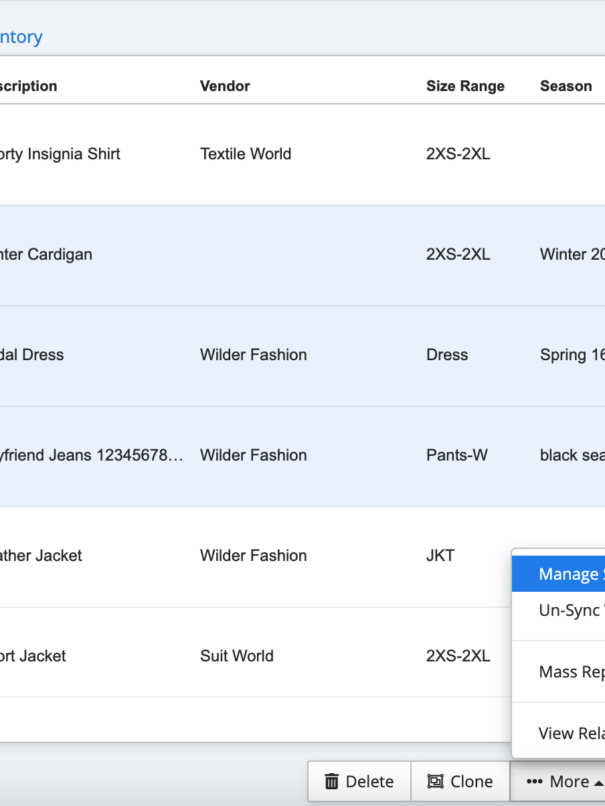In today’s fast-paced retail industry, apparel companies face numerous challenges when it comes to managing their inventory and operations. Poorly managed inventory can lead to lost sales, higher costs, and inefficiency. To tackle these issues, retailers must have a reliable apparel management software solution that can help them manage every part of their business, from bookkeeping to seamless inventory management and software integration solutions that help them boost efficiency even further.
Implementing an apparel software system is enough to maximize efficiency and ROI. As things stand, the apparel management software market size is considered big, and it will continue to grow to exceptional heights, or to be precise, $1399.8 Billion by 2028
Still, you can take apparel software efficacy to a new level, as integration can play a critical role in streamlining processes and further optimizing performance.
In this article, we will explore key strategies for integrating apparel software systems with existing technologies and platforms to achieve maximum efficiency and ROI. By following these strategies, apparel companies can help themselves reap the benefits of a seamlessly integrated system that saves time, reduces costs, and improves overall business operations.

What’s Software Integration
Software integration refers to the process of connecting two or more software applications to work together as a single system. In today’s technology-driven world, many businesses rely on various software tools and systems to manage their day-to-day operations. However, these systems often operate in silos, meaning they don’t communicate with each other, leading to inefficiencies and errors.
Software integration aims to eliminate these issues by creating a seamless flow of data between different software applications. By integrating systems, businesses can streamline their processes, set up automated workflows, and reduce the likelihood of errors that may arise from manual data transfer.
Types Of Software Integrations
There are several approaches to software integration, including point-to-point integration, middleware integration, and API-based integration (Application Programming Interface). Point-to-point integration involves connecting two systems directly using custom code or pre-built connectors. Middleware integration uses a third-party platform that sits between multiple systems and facilitates communication. API-based integration uses standardized interfaces called APIs that allow different systems to communicate.
With the right integrations, you can streamline your business workflows and enjoy a wide range of benefits and a more efficient and profitable business journey.
How the Most Popular Apparel Software Combines ERP and CRM Together
When it comes to software integrations, the coupling of ERP (Enterprise Resource Planning) and CRM (Customer Relationship Management) is an essential pairing that cannot be overlooked. This dynamic duo provides everything that apparel businesses require to achieve maximum efficiency in their operations and streamline every single complicated process you might encounter.
By integrating these two systems, companies can effortlessly pinpoint bottlenecks, prioritize sustainability measures, and increase ROI across all aspects of their operations. In addition, the combination of ERP and CRM provides a comprehensive solution that enables businesses to streamline their processes and optimize performance without sacrificing accuracy or productivity. With this powerful integration in place, they can confidently tackle any business operation they set out to perform with ease and precision.
ApparelMagic enables you just that, the benefits of the two from one streamlined hub. But before we talk about how ApparelMagic can help you, let’s break down how these two systems work.
ERP Vs. CRM
The two critical software systems serve distinct purposes in modern businesses. ERP’s primary objective is to enhance productivity by streamlining business processes across all organizational departments, while CRM focuses on improving customer interactions and client retention. In addition, CRM aims to increase sales, while ERP concentrates on optimizing the precision and efficacy of the entire system.
Some of the key components of an ERP include workflow management, inventory tracking, scheduling, POs (Purchase Orders), invoicing, and other capabilities. This makes it a valuable tool for streamlining and expediting internal organizational tasks such as project planning, finance management, and order fulfillment. By integrating an ERP system into their operations, businesses can improve efficiency and accuracy while reducing manual errors and delays.
While CRM only focuses on helping you manage leads and nurturing them, it’s not uncommon for businesses to do that manually. Now on paper, this might seem like a lackluster feature compared to what ERP offers; however, if you combine them, you can expect to enjoy benefits all across the board and operate as a business that is always on point.
Overall, the combination of ERP and CRM provides a perfect solution that enables businesses to optimize their processes from end to end while enhancing customer satisfaction and driving revenue growth.
The benefits of using these systems include the following:
- Data centralization for easier and faster data entry;
- Improved collaboration across different departments without siloes;
- Reduced data duplication with consistent guidelines and structures;
- Better forecasting by matching customer demand with ERP data;
- Time savings and increased efficiency by avoiding switching between systems;
- Improved customer service and experience through complete visibility of customer data in real time.

The Various Integration Solutions that can Help you Boost Efficiency and ROI
The integrability of ApparelMagic is not limited to just CRM. It can integrate with various platforms such as Shopify and WooCommerce, QuickBooks, and ShipStation. Integrating ApparelMagic with any of these platforms is the answer to the question of how to maximize efficiency and improve your overall business workflows.
1. Shopify
Shopify is the ultimate solution for business owners that are looking to launch their own online stores. With over 4.4. million active stores, this platform has firmly established itself as one of the leading eCommerce solutions on offer today.
Its user-friendly interface and exceptional features make running a store more manageable than ever before. And with ApparelMagic integrated into your shop’s setup, you can effortlessly synchronize data across multiple shops – transforming busywork from tedious into an absolute breeze.
The same can be done with WooCommerce for those that prefer the more familiar WordPress feel.
2. QuickBooks
You can unlock more opportunities for your apparel store with the Quickbooks and ApparelMagic seamless integration solution and run operations quickly without a hitch, selling in any currency to customers around the globe.
With this combination of powerful tools, you can manage critical aspects like customer bills, vendor payments, invoices, and memos – all while keeping track of finances effortlessly.
3. ShipStation
With this powerful integration, you can keep all shoppers updated on their orders and ensure they are constantly updated. This tool is crucial if you want to improve the customer experience you provide.
All users can easily sync their invoices from ApparelMagic to ShipStation, where shipping quotes can be requested with just a click.
Standalone Works
ApparelMagic offers you the flexibility to run your B2B commerce store cost-effectively and with ease. This full-service software is the complete solution as it allows you, as a business, to cut out all middlemen, enabling you to enjoy an enhanced experience when setting up a store with creative templates, and all of that will take you only a few minutes.
With features such as attaching videos, pictures, and much more, you’ll create a store that allows all customers to enjoy a unique experience and have access to preorders of inventory offerings and so much more. This platform can bring greater success through a simplified workflow process without the need for any other app integrations.
The biggest benefit of using an all-in-one solution is the transparency you will enjoy. Having a user-friendly dashboard that consolidates all available tools in one place will boost your performance and, therefore, ensure that you see ROI from using such a powerhouse of an app.
Managing all aspects from a single hub makes it easier to navigate and utilize the tools as needed while providing seamless access to data across different business areas without delays. With all data organized into a single platform, it becomes simpler to comprehend accounting information and its relation to past quarters. Additionally, this consolidated view allows for quick identification of popular products and potential raw material shortages, providing valuable visibility for achieving success.
Final Thoughts
For apparel businesses, software solutions are essential to streamline inventory management and other crucial business operations. Maximizing efficiency and return on investment is easy with the right software integrations. There are several approaches to integration, including point-to-point, middleware, and API-based integration.
Combining ERP and CRM provides a comprehensive solution that optimizes processes end-to-end, enhancing customer satisfaction and driving revenue growth. By integrating Shopify, QuickBooks, and ShipStation with ApparelMagic, businesses can manage finances, streamline operations, and improve the customer experience. Standalone solutions also work well to eliminate middlemen and enhance the user experience when setting up B2B commerce stores.
Following the strategies outlined in this article leads to a seamlessly integrated system that saves time, reduces additional costs related to business operations, and enhances overall business efficiency for apparel companies.







